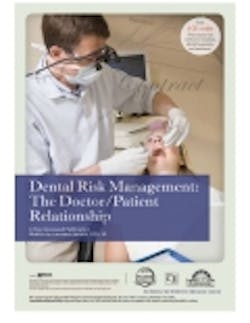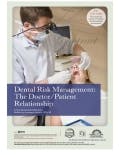Dr. Jeff Dalin interviews Dr. Mic Falkel of Onpharma
Jeffrey B. Dalin, DDS, FACD, FAGD, FICD
For more on this topic, go to www.dentaleconomics.com and search using the following key words: local anesthetics, Onpharma, sodium bicarbonate, Dr. Mic Falkel, Dr. Jeff Dalin.
Dr. Dalin: I get excited when I find a new technology that is one-of-a-kind and will deliver something special for patients. At this year’s Chicago Midwinter Meeting, I met Dr. Mic Falkel at the Onpharma® booth. This company has developed a method of buffering local anesthetic that will allow the delivery of anesthetic injections in a more comfortable and effective way. Dr. Falkel, would you give the readers a summary of the chemistry involved with local anesthetics?
Dr. Falkel: Local anesthetics are powders that are insoluble in water. Because the anesthetics are weak bases, they must be packaged as an acid so they will stay in solution. If the anesthetic has a vasoconstrictor, the overall pH is in the range of 3 to 4 or the equivalent of lemon juice. At this pH, the anesthetic is more than 99% in the charged or “cationic” form, which cannot cross the nerve membrane.
In order for the anesthetic to work, the body must first convert enough of the cationic anesthetic to its uncharged “active” base form. This can cross the nerve membrane, so that the patient achieves profound anesthesia. Now it gets a little more complicated. Once the base form of the anesthetic crosses the nerve membrane, it must be reconverted into the acid form inside the nerve axon to enter the sodium channel and effectively block the action potential or pain impulse.
Dr. Dalin: This reminds me of dental school lectures on anesthesia. How does pH relate to the pain and effectiveness of injections?
Dr. Falkel: pH is an acid-based scale, which means the lower the pH, the more acidic the solution. If our anesthetic has a starting pH of “say” 3.5, then it is approximately the pH of lemon juice. When we give an injection of local anesthetic, we create a wound with the needle and then bathe that wound with lemon juice. Hence the “bee sting” effect for the patient.
The relative amounts of the lipid soluble uncharged form and the lipid insoluble charged form of the local anesthetic in a dental cartridge depend on the pH of the solution. If we want to go back to dental school, the amount of each ionic form at any given pH can be determined by the “Henderson-Hasselbalch” equation.
For example: at a pH of 3.5, there is only one molecule of the “active” uncharged form for every 25,000 molecules of the charged form or essentially zero active form of the drug at the time of injection.
If we could buffer our anesthetic closer to physiologic pH (7.4) immediately before we give the injection, due to the logarithmic nature of the pH scale, there would be 6,000+ times more of the active form of the drug at the time of injection. We would not be bathing the wound we have created with lemon juice.
This is interesting because, on any given day, any given patient’s tissues may or may not have the buffering capacity to buffer the pH of the anesthetic injection enough to create sufficient active anesthetic to make the anesthetic effective. So what I like to say is, “When anesthetic fails, it is the patient’s fault, not the dentist’s fault.” This, of course, assumes the solution was deposited somewhere near the nerve.
Dr. Dalin: Can you provide specifics of how sodium bicarbonate and CO2 work with Onpharma products?
Dr. Falkel: Buffering anesthetic with sodium bicarbonate has been done in medicine for more than 80 years with some amazing but inconsistent results. What we have done at Onpharma is isolate five key variables in the anesthetic buffering process that we know are critical to get the most benefit from buffering and to make it work reliably. Then we created a simple system around controlling for those variables that would allow us to consistently and simply buffer our dental anesthetic cartridges at chairside, immediately prior to injection when buffering is most effective.
Bicarbonate is our body’s buffer so it is a safe buffer to use with anesthetic. By mixing sodium bicarbonate with local anesthetic, two things happen. First, we can raise the pH to near physiologic, which dramatically increases the base or active form of the anesthetic. Second, we can introduce dissolved CO2 into the solution. Having thousands of times more of the active form of the drug available at the time of injection is a massive improvement over waiting for the body to handle the process.
Adding dissolved CO2 into the equation is also a key factor because CO2 serves as a fast-acting independent anesthetic and a catalyst for local anesthetic. As Condouris et al. wrote: “CO2 possesses an independent anesthetic effect and caused a seven-fold potentiation in anesthetic action.”
Dr. Dalin: How do the mixing pen and cartridge connectors work?
Dr. Falkel: Onpharma has three products that work together to allow dental professionals to easily, quickly, and precisely buffer their local anesthetic immediately before injection. First, we have the Onset® Mixing Pen — a reusable compounding device that is about the size of a highlighter pen — Onpharma’s Sodium Bicarbonate Inj., 8.4%, USP Neutralizing Additive Solution, and our Onset® Cartridge Connector.
A cartridge of lidocaine with epinephrine is attached to the pen (using a cartridge connector). The practitioner presses the pen’s button, it buffers the anesthetic cartridge, and then the anesthetic cartridge is removed from the pen and delivered by the practitioner using his or her normal technique and armamentarium. The whole buffering process takes less than 10 seconds.
At the beginning of the day, a cartridge of Onpharma’s sodium bicarbonate solution is placed in the reusable Onset Mixing Pen, which can then be used to buffer anesthetic cartridges throughout the day.
Dr. Dalin: We always look for ways to make patients more comfortable. Please talk about what this can mean to practices daily.
Dr. Falkel: I was taught in dental school that you could build a practice around a comfortable injection. I developed great techniques through years of practice, but regardless of how hard I tried, I still had patients that would feel the “bee sting” of the injection. This is a chemical problem, not a technique problem. If there is anything that we can easily do to reduce injection pain, it will benefit patients, and in return, benefit practices. Buffering our anesthetic takes giving a comfortable injection to a whole new level.
Dr. Dalin: Is there anything else you would like to add?
Dr. Falkel: First of all, Jeff, I would like to thank you and Dental Economics® for the opportunity to discuss Onpharma’s products with your readers. My belief is that the best way for any of us to understand and fully appreciate a new dental technology is to use the technology in practices. Fortunately, our products are not disruptive to the normal practice routine, are simple to learn, and relatively inexpensive. As I like to say, we take a “dud” anesthetic cartridge and make it a silver bullet.
I would encourage everyone to evaluate our products clinically. I believe most practitioners will find they love the improvement it makes to the anesthetic experience for themselves and their patients. We sell our products direct to dentists. Orders can be placed by calling our Customer Care Team at 877-33ONSET (877) 336-6738. To get more information on the science of buffering and our products, visit our website at onpharma.com.
Mic Falkel, DDS, maintains a private practice in Monterey, Calif. Frustrated with the performance of local anesthetic, he began research into the pharmacokinetics of the drugs. Based on this research, he developed a reliable and convenient way to adjust the pH of lidocaine with epinephrine just prior to injection. He is the cofounder of Onpharma. Reach him at [email protected].
Jeffrey B. Dalin, DDS, FACD, FAGD, FICD, practices general dentistry in St. Louis. He is a cofounder of the Give Kids A Smile program. Contact Dr. Dalin at [email protected].

